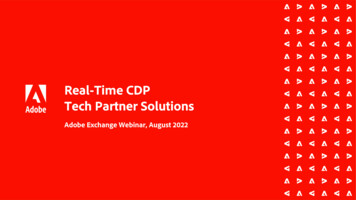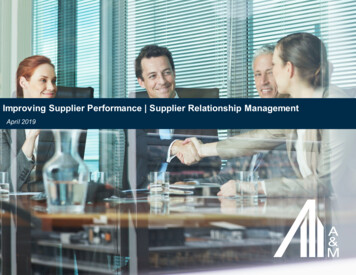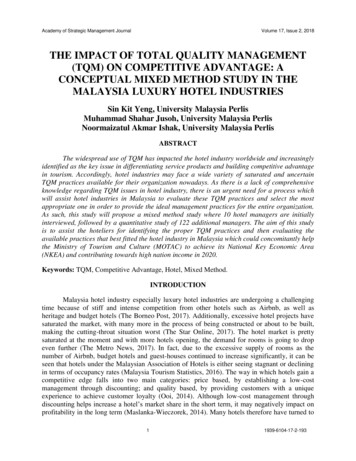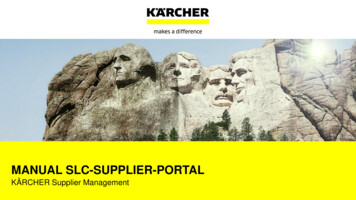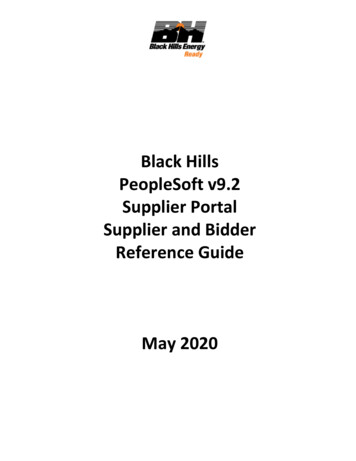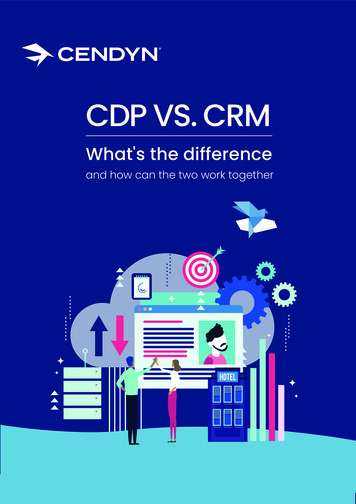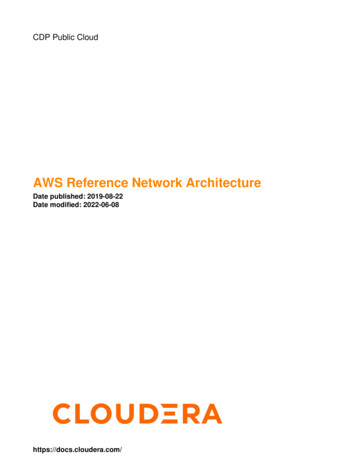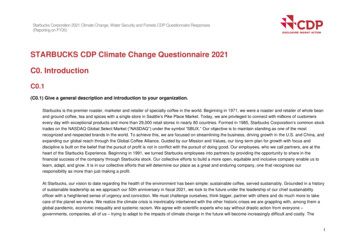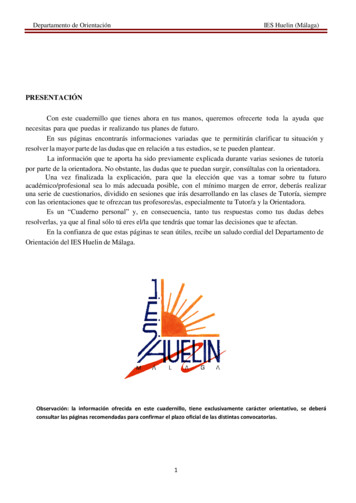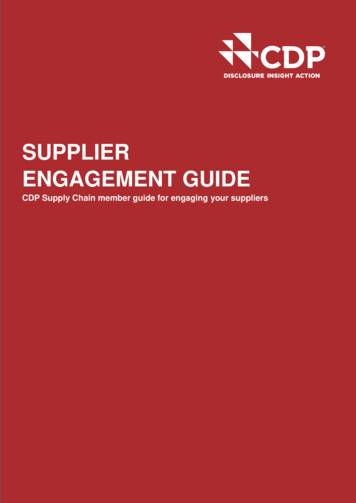
Transcription
SUPPLIERENGAGEMENT GUIDECDP Supply Chain member guide for engaging your suppliers1
Purpose of this documentThis document aims to help CDP Supply Chain members communicate and engage withsuppliers before, during and after the disclosure period. Effective engagement with yoursuppliers will help your suppliers understand the process and why their response isimportant to you. This will lead to better response rates, a higher quality of responses andbetter management of climate change, deforestation and forest degradation, and watersecurity issues in your supply chain.2@cdp www.cdp.net
SUPPLIER ENGAGEMENTA CDP Supply Chain member guide for supplier engagement in2022ContentsINTRODUCTION . 4SUPPLIER ENGAGEMENT METHODS . 8Tailored emails from member to supplier . 8Create a supplier A list . 8Supplier feedback and prep webinar . 9Supplier recognition event/awards . 10Procurement trainings . 10Supplier Profiles/Scorecards . 11Supplier support webinars . 14Supplier guidance documents . 14Direct Supplier Support . 15Contact companies about collaborative opportunities . 15THINGS TO CONSIDER . 16Supplier response status’ last year. 16Supplier’s level of response . 17Whether the supplier is a small company/first time responder . 17EMAILS FROM CDP TO SUPPLIERS. 17EMAILS FROM MEMBERS TO SUPPLIERS . 17Key messages to communicate to suppliers . 18Updated February 20223@cdp www.cdp.net
INTRODUCTIONEffective engagement with your suppliers will help them to understand the CDP annualDisclosure Cycle process and why their response is important to you, leading to betterresponse rates, a higher quality of responses, and better management of climate change,deforestation and forest degradation, and water security issues in your supply chain.How you engage will depend on what you want to see from your suppliers. Do you have anyKPIs you measure against? Or targets? What gaps have you spotted in the data you havecollected previously? This will help you to focus your engagement and set your suppliers’expectations.Using a combination of webinars, email, phone and in-person correspondence to reiteratethe importance of completing the CDP questionnaire can ensure your message is gettingthrough. It can also be useful to leverage the relationship supplier managers/procurementteams hold. We see that members who engage their suppliers frequently and directly andthose who have integrated supplier engagement strategies on environmental issues intotheir procurement processes, usually have the highest response rate and most success inthe program. By engaging your suppliers early, you can ensure enough time to locate whothe most effective person is to contact about disclosure and ensure they are aware that yourequire their environmental data. Through direct engagement, you will also be able to open adialogue about sustainability that can be continued throughout the year.Whilst we realize that the level of your direct engagement will vary depending on theresources and time available to you, your direct supplier engagement can make a bigdifference to the responses you receive. Your account manager can help you to draw up anddeliver your specific supplier engagement plan to achieve your aims and objectives.Technical noteFigures indexed within this document are taken from a 2019 survey based on Supply Chainmembers based in North America.4@cdp www.cdp.net
SUPPLIER ENGAGEMENT TIMELINEThis supplier engagement roadmap provides an overview of what and how you should becommunicating to your suppliers or internal teams at different times of the CDP DisclosureCycle.5@cdp www.cdp.net
SUPPLIER COMMUNICATION PLANMember communicationCDP communicationMarch: Supply Chain members to email requestedcompanies the link to the ‘Join an Organization’form and notify suppliers that they are beingrequested to disclose to CDPMid-April: Additional email sent by CDP to suppliers Your account manager will provide you with arecommended mailing list and template text to sendto your suppliers depending upon their disclosurestatus.For new responders, the template text will includethe ‘Join an organization’ link.You can edit the template text to encourage yoursuppliers to respond, clearly articulating why youare asking them to disclose (including benefits ofresponding, ramifications of declining to participate,key focus questions etc.)Make your procurement teams aware and set upwebinars to engage themSet up webinars for your suppliers with youraccount manager April-May: Update contacts and request thatsupplier queries you cannot answer be sent to theHelp Center Respond to any supplier queries that are bestanswered by you. Request that any queries that you cannot answer bedirected to the new CDP Help Center when itlaunches to companies shortly, in the meantime,please continue to direct queries torespond@cdp.net The new multi-lingual Help Center will replace therespond@cdp.net email support channel. It willenable companies to find answers to commonqueries and contact our support team. Companieswill be informed when the Help Center is available.End of May: Monitor supplier progress using thesupplier tracker on your dashboard Remind suppliers who have not yet registered orconfirmed their intention to respond, about theimportance of their response.Reach out to first time responders and encourage abasic response this year. Beginning July: Contact all suppliers still listed as‘No response’ Calling is most effective to find out why they haveCDP’s Online Response System (ORS) opens for theyear. CDP sends an email to each supplier that hasregistered to disclose. You will be able to find a copy ofthis email on your dashboard once it has been sent.End April: Finalize with your account manager howyou would like to conduct your supplier supportwebinars Supplier support webinars are an integral part of yourengagement strategy. They reiterate the importance ofa supplier response and give you the opportunity tohighlight key data points you want addressing.Account managers will be on hand to answer anysupplier queries.May: First reminder email sent to suppliers CDP will send a reminder email to all registeredsuppliers who have not yet submitted a response.June: Second reminder email sent to suppliers A further reminder will be sent out by CDP to supplierswho have not yet submitted.not responded, find out if they intend to respondand address any problems.6@cdp www.cdp.net
Mid-July: Call all suppliers who have not submitted Calls can help find out if they intend to respond andis an opportunity for you to help them address anyproblems they may have.Last week of July: Deadline for suppliers to submitand receive a CDP scoreMid-August: Call all suppliers who have notsubmitted Call all suppliers listed as ‘No response’, ‘Confirmedintention’ and ‘Activated’ to encourage them tosubmit at least a basic response by the deadline.Beginning of September: Call all suppliers whohave not submitted Call all suppliers listed as ‘No response’, ‘ConfirmedJuly: Third reminder email sent to suppliers A third reminder will be sent out by CDP to suppliers whohave not yet submitted.To see the timeline for this year, visit our website.August: Fourth reminder email sent to suppliers A fourth reminder will be sent out by CDP to supplierswho have not yet submitted.September: Final reminder email sent to suppliers A final reminder will be sent out by CDP to suppliers whohave not yet submitted.intention’ and ‘Activated’ to encourage them tosubmit at least a basic response by the deadline.7@cdp www.cdp.net
SUPPLIER ENGAGEMENT METHODSTailored emails from member to supplierThe Supply Chain member is responsible for sending the initial registration email for the2022 disclosure cycle. CDP will complement and support this request with reminder emailssent to your suppliers. This email is an opportunity to focus on why your suppliers’responses are important to you, what you expect from their response, how you use theirdata, what will happen if they do not respond, links to guidance, and details of any upcomingwebinars. See page 17 for a way to provide tailored emails and suggestions for keymessaging. A template email is available on your dashboard.CASE STUDY: KPMGSending a supplier feedback letterA Supply Chain member for eight years, KPMG has built a strong systemfor communicating with suppliers during the disclosure period and hasachieved a top tier response rate since 2017.In 2018, in anticipation of an expansion of the program’s reach, KPMGsent out tailored supplier feedback letters for the first time. Thesereported directly to suppliers on how they had met each of the coresustainability KPIs and provided clear recommendations for desiredimprovement for the next reporting cycle.feedback produced a spike in supplier engagementThe feedback produced a spike in supplier engagement with KPMG'ssustainability strategy. Sustainable Procurement worked closely withcategory managers to address each supplier query, discussing KPMG'sexpectations of supplier sustainability from the benefits of disclosure toenquiries into closer collaboration on emissions reduction projects.As a result, KMPG buyers were able to become active advocates of thesustainable procurement program, offering KPMG an opportunity to driveaction across all areas of focus and further support suppliers to provide thehigh-quality data crucial to their own strategy and targets.Create a supplier A listCDP publish the annual Climate Change, Forests, and Water Security A List whichcelebrates the top responding companies for that year. Members may want to createsomething similar for their own suppliers to encourage healthy competition and improvedresponses. Members are advised not to release their supplier scores as they are private,unless they achieve an A.8@cdp www.cdp.net
Supplier feedback and prep webinarMany of our members have taken up the opportunity to hold a supplier feedback webinar.This is to acknowledge their suppliers’ work, provide an overview of how they performed,and show what their requesting customer is doing to justify their request for supplierenvironmental data. Some members have held this webinar in October-Decemberimmediately following supplier submissions, whilst other members prefer to hold this inJanuary-March to also prepare suppliers for their next request. The latter option allowsmembers to highlight the guidance and support available as well as explaining what theywould like to see from their suppliers for the upcoming cycle. Many members will focus ongetting non-responders to start responding in the first instance, and then have anexpectation for suppliers to report their scope 1 and 2 emissions and set a reduction target.Suppliers are very interested to hear how they can meet their customers’ expectations.For 2022, we would highly recommend hosting a supplier webinar between January andMarch to highlight the improvements that CDP have made to the Disclosure Cycle andensure that this is well communicated to your suppliers.33% of CDP Supply Chain members1 sent direct feedback to suppliers via email with mostusing CDP’s pre-made supplier feedback email templates that are available to all memberson their dashboard.CDP Supply Chain members who sent direct feedback to suppliers performed better inmultiple CDP key performance indicators versus those Supply Chain members who did not: Average Response Rate: 71% vs. 64% Average CDP Climate Scores: B (8.7) vs. B (8.5) Average CDP SER Scores: A- (9.1) vs. B (8.6)CASE STUDY: L’ORÉALe-learning, workshops, annual strategy meetingsand coaching for suppliersBy 2030, L’Oréal’s strategic suppliers will reduce their direct emissions(Scope 1 and 2), by 50% in absolute terms, compared with 2016. Duringthe COP21 in 2015, L’Oréal pledged those suppliers representing 80% ofdirect purchases will not only participate to the CDP Supply Chainprogram, but also will set targets for reducing their emissions, and willcommunicate on their action plans to succeed in reaching this target.L’Oreal are also making huge strides when it comes to their reduction inboth sustainability management and efforts to preserve naturalresources.L’Oréal’s growing coverage in spend is due to the joint commitment ofpurchasing and environmental experts that conduct a strong process to1Based on a 2019 study with Supply Chain members based in North America.9@cdp www.cdp.net
convince, train, support suppliers to answer to CDP and improve theircarbon footprint.A strong process to convince, train and support suppliersThe main actions include an online toolbox with e-learnings dedicated toCDP; workshops and in 2018, six webinars to help and guide thesuppliers; one-to-one meetings. In addition, the CDP SupplierProfile/Scorecard is commented by L’Oréal and sent to the suppliers priorto the annual strategic meetings.Supplier recognition event/awardsSome members hold annual in-person events to recognize and reward their suppliers. In thepast members have also held an awards event including CDP awards such as ‘mostimproved supplier’, ‘best scoring supplier’, ‘supplier with biggest emissions reduction’.These events make suppliers feel their response is contributing to something bigger andbecause they know their customer is looking at their response, they are more likely torespond.16% of CDP Supply Chain members report integrating CDP data into their organization’ssupplier score-carding system.o CDP Supply Chain members who integrated CDP data into their SupplierProfiles/Scorecards performed better along multiple CDP key performance indicatorsversus those Supply Chain members who did not: Average response rate: 68% vs. 64% Average CDP Climate scores: A- (9.3) vs. B (8.3) Average CDP SER Scores: A (9.7) vs. B (8.4)Procurement trainingsBetween December and March, many members hold annual trainings with their procurementteam with support from CDP to boost internal collaboration and in-turn improve supplierengagement and the overall CDP Supply Chain program delivery. Procurement trainingseducate your organization’s purchasing function on key topics such as: What CDP and the Supply Chain program areWhy should it be important to them?What is asked of their suppliers during the Disclosure Cycle?What key dates should the procurement teams be aware of?CDP has materials to support these trainings that are designed to be accessible andincludes content to be both relevant and understandable for procurement professionals.Please utilize the Procurement Guides in your member dashboard for more procurementrelevant information about the Supply Chain program. Trainings are typically held as online,10@cdp www.cdp.net
1-hour webinars, but have also been held as pre-recorded videos and even live trainings inthe past. Please contact your account manager if you are interested in hosting a training foryour procurement team for the upcoming disclosure cycle.26% of CDP Supply Chain members hosted a procurement training.CDP Supply Chain members who hosted a procurement training performed better alongmultiple CDP key performance indicators versus those Supply Chain members who did not: Average response rate: 70% vs. 65% Average CDP Climate scores: B (8.7) vs. B- (8.5) Average CDP SER Scores: B (8.8) vs. B (8.8)19% of CDP Supply Chain members reported integrating CDP data into their internalprocurement systems.CDP Supply Chain members who integrated CDP into their procurement systems performedbetter along multiple CDP key performance indicators versus those Supply Chain memberswho did not: Average response rate: 78% vs. 62% Average CDP Climate scores: A (9.5) vs. B (8.5) Average CDP SER Scores: A- (9.4) vs. B (8.5)Supplier Profiles/ScorecardsSupplier Profiles, also known as Supplier Scorecards, are provided as part of Lead andPremium memberships, or available to Standard members at an additional cost. A profile iscreated for each supplier for Climate Change / Forests /Water Security. Each scorecardprovides a one-page summary of that supplier’s performance; an example is provided below.They are mostly used by our members to provide a basis for conversations betweensuppliers and the relationship holders in procurement teams. L’Oréal use their supplierprofiles in their annual reviews with each supplier. The supplier profiles are designed to beused by procurement teams; we have guides to accompany them which explain what eachsection shows. The supplier relationship held by procurement teams is often the bestrelationship a company has with its supplier, so including procurement teams into theprocess can reinforce the messages and improve response rates and quality. We canprovide training by webinar (or in–person training for Lead members) for your procurementteams to introduce CDP, how to use the supplier scorecards, ways they can engage withsuppliers and how you are performing.12% of CDP Supply Chain members reported incorporating language on CDP participationor scoring into contracts with requested suppliersCDP Supply Chain members who integrated CDP disclosure or scoring into contractlanguage with suppliers performed better along multiple CDP key performance indicatorsversus those Supply Chain members who did not: Average response rate: 81% vs. 61% Average CDP Climate scores: A- (9.0) vs. B (8.5) Average CDP SER Scores: A (9.8) vs. B (8.5)11@cdp www.cdp.net
Example of a CDP Climate Change Supplier Profiles/Scorecards12@cdp www.cdp.net
Example of a CDP Water Security Supplier Profiles/ScorecardsExample of a CDP Forests Supplier Profiles/Scorecards13@cdp www.cdp.net
Supplier support webinarsWe hold a series of free live and recorded webinars throughout the disclosure period forsuppliers. These can be found on the supplier dashboard when they log in, on CDP’s eventswebpage www.cdp.net/events and suppliers can sign up to receive CDP’s newsletter.We can also hold webinars throughout the year with Supply Chain members specifically fortheir own suppliers. It works well when a speaker from your company who suppliersrecognize helps to reinforce the importance of your suppliers’ responses. We find supplierspecific webinars see a much higher attendance rate than our program of generic supportwebinars and is a great opportunity to explain your strategy, how you use your supplier dataand focus your suppliers’ attention on the data points you are most interested in.59% of CDP Supply Chain members hosted a supplier support webinaro CDP Supply Chain members who hosted a supplier support webinar performed betteralong multiple CDP key performance indicators versus those Supply Chain memberswho did not: Average response rate: 68% vs. 64% Average CDP Climate scores: B (8.7) vs. B- (8.2) Average CDP SER Scores: A- (9.0) vs. B- (8.0)Supplier guidance documentsCDP offers multiple guidance documents that are available to Supply Chain members that aredesigned to help your suppliers with responding to CDP:Resources from CDP for Disclosure in 2022: (please note that some resources mayrequire you to log into your CDP Supply Chain member dashboard) CDP Guidance and scoring methodology for companies Bite Sized Guidance for new disclosers- Climate Change Bite Sized Guidance for new disclosers- Water Security (available soon) Bite Sized Guidance for new disclosers – Forests FAQs – Find answers to common queries CDP Supply Chain Report 2021: Engaging the Chain 2022 CDP Supplier Support Webinars CDP Disclosure Platform Guide (currently being updated for 2022) The CDP Roadmap & organizational guide to climate actionGHG Emissions Accounting and Science-Based Targets: GHG Protocol Corporate Standard GHG Protocol Calculation Tools CDP Technical Note on Science-Based Targets FAQs - The Science Based Targets InitiativeWater Accounting and Risk Assessment: Global Water Footprint Assessment Standard WRI Water Risk AtlasWe encourage you to utilize these documents and share them widely in order to help addressconcerns and issues that your suppliers may encounter while disclosing. Additionally, pleasecontact your account manager if there are additional areas of CDP guidance that you wouldlike to communicate to your suppliers.14@cdp www.cdp.net
Direct Supplier SupportAny questions that you are unable to answer can be directed to CDP’s Help Center that willbe replacing the respond@cdp.net inbox in 2022. Companies will be informed when theHelp Centre is available.In addition, each member is provided with a CDP email address to provide to their suppliersfor Supply Chain member specific questions. Your contact detail will look similar to this:SC.MEMBER@cdp.net (replace member with your organization’s name)For one-to-one support on disclosure, CDP’s Reporter Services program providespersonalized disclosure support to help organization’s best respond to the questionnairesand improve their environmental practices. For more information, please contactreporterservices@cdp.net.And finally, please contact the CDP Commit-To-Action team at commit@cdp.net if you oryour supplier would like more information on how to set a science-based target.Contact companies about collaborative opportunitiesQuestion SC2.1 in the supplier module of the supply chain questionnaire asks your suppliersto propose ideas for ways you could collaborate with them to reduce emissions. Manymembers have decided to follow up with each company that responded to the questionindividually to discuss how they could take forward the project. Some have decided to do thiseven if the project is not feasible as they believe other things will come from the conversationsuch as more ideas for collaboration, an improved relationship, and a chance to show thesupplier that their response is read and is important to the member.15@cdp www.cdp.net
THINGS TO CONSIDERWhen contacting your suppliers, it is useful to consider their response status from theprevious year, your current spend with the supplier, the extent of data provided in theirresponse and the size of their company. This will help you to decide the best way to tailoryour contact with them and to offer the support that is most relevant to them or provide themwith the best incentive to improve their response.Supplier response status’ last yearDepending on how your supplier responded last year you can target your engagement withthem as suggested in the table below. You will find your suppliers’ responses status in thedata extract and snapshot.StatusSubmitted ClimateChange/ Forests/Water SecurityquestionnaireDeclinedNo ResponseExplanationSuggested engagement this yearThe supplier has completed theirquestionnaire and submitted aresponse.Ask the supplier to improve their response by directingthem to the advanced guidance documents or hold awebinar for advanced disclosers with CDP. Considertheir score and encourage them to book a feedbackcall with our scoring partners. You could also havediscussions about collaborative opportunities theyhave suggested and recognize their achievements.The supplier has communicated toyou or CDP that they do not intendto respond this year and provided areason.Ask your account manager if they provided a reasonfor declining and work to persuade them to respondthis year. Perhaps leverage the supplier manager’srelationship and encourage a basic response this year.Encourage the supplier to provide a basic responseThe supplier has not yet entered thethis year and point them towards the support CDP canonline response system (ORS) toprovide them with. Perhaps hold a webinar aimed atindicate they will respond this year.first time responders.ActivatedA representative of the supplier hasentered the ORS and begun to enterdata but has not yet submitted theresponse.Contact the supplier to find out why they did notsubmit. If they were overwhelmed by thequestionnaire explain that a basic response is betterthan none at all and point them towards the supportCDP provides. It may be that they did not realize theyhad to click ‘submit’.ConfirmedintentionA representative of the supplier hasentered the ORS, activated thequestionnaire, but did not startanswering the questions.Contact the supplier to find out why they did notsubmit. If they were overwhelmed by thequestionnaire explain that a basic response is betterthan none at all and point them towards the supportCDP provides.The questionnaire was submittedafter the extended deadline date.Responses will no longer be classified as LateSubmissions this year. These suppliers should beengaged with the same as suppliers with a “SubmittedClimate Change/ Forests/ Water Securityquestionnaire” status.Late Submission16@cdp www.cdp.net
Supplier’s level of responseConsidering whether a supplier completed most of the questionnaire or only a few questionswill help you to offer the most relevant support for them. The Snapshot report available inyour dashboard will help you to easily identify which parts of the questionnaire the suppliercompleted and which they didn’t. If the supplier completed few questions, direct them to thedata points you are particularly interested in or encourage them to improve their disclosurescore by answering as many questions as they can. If their response is more complete, youcan drive performance by encouraging them to sign up to wider commitments, such asRE100 or SBTi, or by proposing a collaborative project to reduce emissions together.Whether the supplier is a small company/first time responderSmaller companies and first-time responders often have more reservations aboutresponding because of the resources needed to complete the questionnaire/level ofknowledge and understanding of the topic. To help first-time responders and Small andMedium-Sized Enterprises (SMEs) respond, we have designed a shorter (minimum) versionof the questionnaire they can opt into. The minimum questionnaire also has its own scoringmethodology available on the guidance page of the website.EMAILS FROM CDP TO SUPPLIERSCDP will send a notification email to suppliers who have registered with CDP and beensuccessfully linked with their company response. CDP will also send monthly reminderemails to those suppliers, as outlined in the supplier communications plan at the start of thisdocument. A copy of the text CDP sends to suppliers will be available on your dashboard.EMAILS FROM MEMBERS TO SUPPLIERSMembers are asked to send the initial communication to suppliers that provides the link tothe ‘Join an Organization’ form and outlines your goals for the 2022 Disclosure Cycle whilstalso giving authority to the emails sent from CDP throughout the disclosure period. We havea template email/letter available on your dashboard that you can use, but as suppliers willlikely receive multiple communications, creating your own one would likely be better receivedby your suppliers. To help you, we have listed key message suggestions below andinformation you might like to include in this email. Contact your account manager if youwould like to discuss targeted communications with your suppliers further.17@cdp www.cdp.net
Key messages to communicate to suppliersSuggested content for emails is: Why you are requesting that they disclose through CDP Clear outline of how the supplier should register to the CDP website and how theprocess has improved from the previous years What you plan to do with the information provided and any specific CDP questionsthat are of interest to you How this initiative fits in with your company’s goals Why climate change/forests/water security are critical business issues Your company’s own experience in responding to CDPo A link to your company’s own CDP responseo Learning opportunities realized through the disclosure processo Benefits of responding such as setting a clear strategy, cost savings,improved reputation Timelines / deadlines How suppliers can get support from CDP such as via respond@cdp.net (and theHelp Center when it becomes available)Articulate why you want suppliers to respond to the information request:For example: Increased awareness of supply chain risk through measurement and disclosure of theregulatory and physical impacts of climate change Improved reporting capability through increased ability to report on Scope 3 emissions Identify opportunities for joint emissions reduction projects with suppliers Identify examples of best practice in emissions reduction activitiesExplain some of the benefits for suppliers: One response for all requesti
8 @cdp www.cdp.net SUPPLIER ENGAGEMENT METHODS Tailored emails from member to supplier The Supply Chain member is responsible for sending the initial registration email for the 2022 disclosure cycle. CDP will complement and support this request with reminder emails
